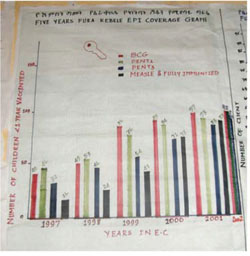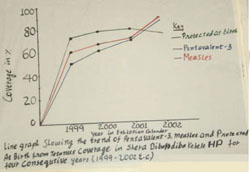8.1.9 Monitoring and evaluation indicators
Monitoring and evaluation are crucially important parts of any health plan. Monitoring refers to the continuous observation and collection of relevant data, and evaluation means analysing the data to see if you are meeting your objectives. Therefore, you need to select reliable indicators of progress for each of the objectives in your action plan. Collecting and analysing data from these indicators is an essential activity during the implementation of your immunization programme.
Indicators of progress in immunization programmes
Some of the main EPI indicators of progress that are commonly used to monitor and evaluate immunization programmes are given below:
- Immunization coverage rate for each vaccine, i.e. the percentage of all eligible children who have received all doses of a vaccine under one year of age, according to the EPI schedule.
- Percentage of fully immunized children aged under one year, who have received all recommended doses of all vaccines (including measles vaccine at age 9 to 11 months), according to the EPI schedule (Figure 8.6).

Years in Figure 8.6 are given in the Ethiopian calendar (E.C.), and correspond to 2005–2010 in the European calendar.
- Percentage of pregnant women with adequate TT doses, defined as receiving any of TT3, TT4 or TT5. This indicator is often abbreviated to TT2+ (because more than two doses of TT vaccine have been given).
- Percentage of children protected at birth (PAB) from neonatal tetanus, because their mother received a valid dose of TT2+ vaccination at least two weeks before delivery (Figure 8.7).

- Dropout rates: the percentage of children and mothers not completing all the scheduled EPI immunizations.
- Reported new cases in the community of:
- neonatal tetanus
- acute flaccid paralysis (AFP)
- measles in children under five years of age
- all vaccine-preventable diseases.
- Number of reports of adverse events following immunization (AEFIs).
- Vaccine wastage factors
- Reporting completeness, accuracy and timeliness.
You learned how to calculate vaccine wastage factors in Study Session 5. Monitoring and reporting procedures are taught in Study Session 10.
The collection of data on your EPI progress indicators during the year will help you to assess how well you are meeting the objectives of your action plan. You may need to revise your activities if monitoring and evaluation suggests that more needs to be done in order to achieve your objectives.
8.1.8 Implementing your action plan and maintaining community support
